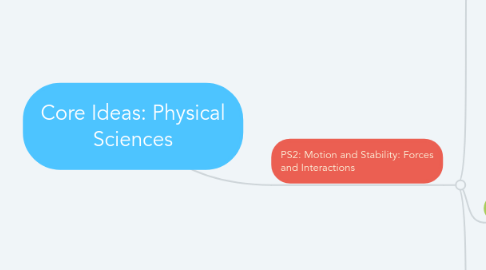
1. PS2: Motion and Stability: Forces and Interactions
1.1. PS2.A: Forces and Motion
1.1.1. An individual force acts on an object and is described by its strength and direction.
1.1.2. A static object usually has multiple forces acting on it, but they sum to zero.
1.1.3. Forces on an object can change its shape or orientation.
1.1.4. Newton's Third Law: For a pair of interacting objects, the force exerted by the first object on the second object equals in strength to the force the second object exerts on the first in the opposite direction.
1.1.5. Newton's Second Law of Motion: F=ma (total force = mass times acceleration)
1.1.6. The greater the mass, the greater the force needed to put the object in motion.
1.1.7. Momentum is the mass times the velocity of the object. In any system, momentum is conserved.
1.2. PS2.B: Types of Interactions
1.2.1. All forces between objects arise from a few types of interactions: gravity, electromagnetism, and strong and weak nuclear interactions.
1.2.1.1. Gravitational, electric, and magnetic forces between objects do not require direct contact.
1.2.2. Objects with mass are sources of gravitational fields.
1.2.2.1. Gravitational forces are always attractive.
1.2.3. Electric forces and magnetic forces are different aspects of a single electromagnetic interaction.
1.2.3.1. Forces and be attractive or repulsive. Depending on the relative sign of the electric charges involved, direction of current flow, and the orientation of the magnets.
1.2.3.2. Force's magnitudes depend on magnitudes of the charges, currents, and magnetic strengths, and distances between interacting objects.
1.2.4. All objects with electrical charge or magnetization are sources of electric or magnet fields and can be affected by the electric or magnetic fields of other objects.
1.3. PS2.C: Stability and Instability in Physical Systems
1.3.1. Events and processes in a system typically involve multiple interactions occurring simultaneously or in a sequence.
1.3.2. Stable system: any small changes results in forces that return the systems to its prior state.
1.3.3. Static but unstable system: any small change leading to forces that tend to increase that change.
1.3.4. Changing system with stable repeating cycle of changes: regular patterns of change that are predictable.
1.3.5. Stable system that appears to be unchanging: flows or processes within it are going on at opposite but equal rates.

